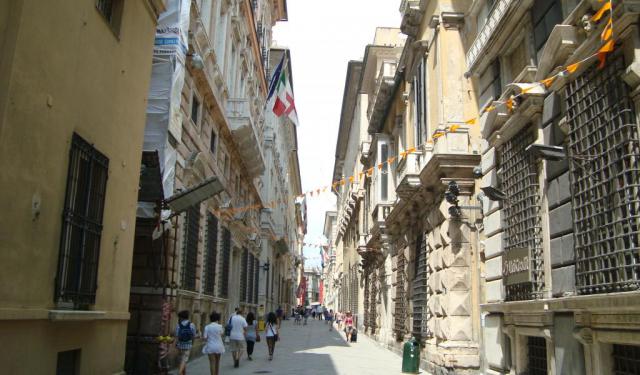
Palazzo Doria (Doria Palace), Genoa
Palazzo Doria, otherwise known as Palazzo Gio Battista Spinola or Palazzo Andrea e Gio Batta Spinola, is the palace situated at 6 Via Garibaldi. This was one of the 163 Palazzi dei Rolli of Genoa originally selected to accommodate notable guests of the Republic of Genoa back in the old days.
The site on which the building stands was purchased, via auction, in 1551 by Constantino Gentile; he later sold it, for a double price, to the brothers Giambattista and Andrea Spinola. The brothers commissioned construction of the palace in 1563. In 1566, Andrea passed his share of ownership to Giambattista, which sped up the construction; by 1567 it was almost completed.
Until recently, Giovanni Battista Castello was believed to be the chief architect of the building. However, the documents unearthed in 1968 revealed Bernardino Cantone to be the one in charge. Only the fireplace on the “piano nobile” (main floor), and the internal courtyard are still attributed to Castello.
Palazzo Doria was the only palace in Strada Nuova (current Via Garibaldi) to be seriously damaged by the French naval bombing in 1684. The ensued restoration of the building, performed by architect Gio Antonio Ricca, saw addition of a story and redesign of the whole façade. Still, the 17th-century alterations did not affect the original sequence of the atrium, courtyard and garden created by Castello.
In 1723, the palace was purchased by the Doria family. The Dorias did not see any need for refurbishing the property beyond routine repairs and only added a notable lantern in the atrium with their family coat of arms.
Presently, the palace still remains the property of the Doria family, as their residence. Only the exterior and limited internal areas are open to the public.
The site on which the building stands was purchased, via auction, in 1551 by Constantino Gentile; he later sold it, for a double price, to the brothers Giambattista and Andrea Spinola. The brothers commissioned construction of the palace in 1563. In 1566, Andrea passed his share of ownership to Giambattista, which sped up the construction; by 1567 it was almost completed.
Until recently, Giovanni Battista Castello was believed to be the chief architect of the building. However, the documents unearthed in 1968 revealed Bernardino Cantone to be the one in charge. Only the fireplace on the “piano nobile” (main floor), and the internal courtyard are still attributed to Castello.
Palazzo Doria was the only palace in Strada Nuova (current Via Garibaldi) to be seriously damaged by the French naval bombing in 1684. The ensued restoration of the building, performed by architect Gio Antonio Ricca, saw addition of a story and redesign of the whole façade. Still, the 17th-century alterations did not affect the original sequence of the atrium, courtyard and garden created by Castello.
In 1723, the palace was purchased by the Doria family. The Dorias did not see any need for refurbishing the property beyond routine repairs and only added a notable lantern in the atrium with their family coat of arms.
Presently, the palace still remains the property of the Doria family, as their residence. Only the exterior and limited internal areas are open to the public.
Sight description based on Wikipedia.
Want to visit this sight? Check out these Self-Guided Walking Tours in Genoa. Alternatively, you can download the mobile app "GPSmyCity: Walks in 1K+ Cities" from Apple App Store or Google Play Store. The app turns your mobile device to a personal tour guide and it works offline, so no data plan is needed when traveling abroad.
Palazzo Doria (Doria Palace) on Map






Sight Name: Palazzo Doria (Doria Palace)
Sight Location: Genoa, Italy (See walking tours in Genoa)
Sight Type: Attraction/Landmark
Guide(s) Containing This Sight:
Sight Location: Genoa, Italy (See walking tours in Genoa)
Sight Type: Attraction/Landmark
Guide(s) Containing This Sight:
Walking Tours in Genoa, Italy
Create Your Own Walk in Genoa
Creating your own self-guided walk in Genoa is easy and fun. Choose the city attractions that you want to see and a walk route map will be created just for you. You can even set your hotel as the start point of the walk.
Rolli Palaces Walking Tour
The Rolli di Genova – or, more precisely, the Rolli degli alloggiamenti pubblici di Genova (Italian for "Lists of the public lodgings of Genoa") – were first established in the Republic of Genoa in 1576. Originally, these official lists included private palaces and mansions belonging to the most distinguished local families, which - if chosen through a public lottery - were obliged... view more
Tour Duration: 1 Hour(s)
Travel Distance: 0.4 Km or 0.2 Miles
Tour Duration: 1 Hour(s)
Travel Distance: 0.4 Km or 0.2 Miles
Genoa Introduction Walking Tour
Petrarch, an Italian poet of the early Renaissance known as the "father of humanism," called Genoa "La Superba" (The Proud One). Genoa is deservedly proud of her maritime glory and unique architecture.
From the 11th century until the late 18th century, the city became a leading economic and military power in Europe. It was one of the wealthiest cities in the world through... view more
Tour Duration: 2 Hour(s)
Travel Distance: 3.8 Km or 2.4 Miles
From the 11th century until the late 18th century, the city became a leading economic and military power in Europe. It was one of the wealthiest cities in the world through... view more
Tour Duration: 2 Hour(s)
Travel Distance: 3.8 Km or 2.4 Miles


